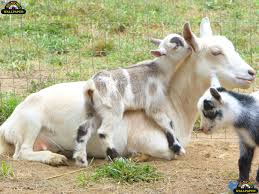Growth response and nutrient digestibility of West African Dwarf goats fed micro doses of dietary aflatoxin
Keywords:
Aflatoxin;Goats;Nutrient utilization;PerformanceAbstract
An experiment was conducted with twenty West African Dwarf (WAD) goats (4-5 months old) averaging 8.40±0.2kg to assess performance and nutrient digestibility of WAD goats exposed to varied levels of dietary aflatoxin of 0ppb, 50ppb, 100ppb and 150ppb in concentrate diets 1, 2, 3 and 4 respectively for a period of 12 weeks. Aflatoxin contaminated maize was used with uncontaminated maize to vary the level of aflatoxin concentration in the concentrate diets. Feed intake, body weight and weight gain were monitored throughout the experimental period and the nutrient digestibility in the experimental animals was determined. Results showed that the average weight gain (g/goat) at the end of the trial declined with increasing aflatoxin level in the diets by 50.97%, 64.70% and 76.48% in animals fed diets 2, 3 and 4 respectively compared to the mean weight gain of the control (36.4g). The feed consumption of goats fed control diet was different from diet 4, but both were higher than those fed diets 2 and 3. Feed intake of goats fed diet 3 was higher than those on diet 2. Forty percent mortality was recorded in each of treatments 2, 3 and 4. Nutrient digestibility was influenced by dietary aflatoxin, but no consistent trend was observed with increase in aflatoxin concentration. These results suggest dietary aflatoxin up to 50ppb impaired performance of WAD goats. It also impaired nutrient digestibility, utilisation and depressed growth most especially when fed at 100 ppb and 150ppb to WAD goats.
References
A.O.A.C., 2000. Association of official analytical chemists. Official methods of Analysis 16th edition.
Washington. D.C USA.
Abdel-Fattah, S.M., Abosrea, Y.H., Shehata, F.E., Rady, F.M., Helal, A.D., 2010. The Efficacy of Thyme Oil as
Antitoxicant of Aflatoxin(s) Toxicity in Sheep. J. Amer. Sci., 6(10).
Agag, B.I., 2004. Mycotoxins in foods and feeds 1-aflatoxins. Ass. Univ. Bull. Environ. Res. Vol. 7 No. 1,pp 173-205.
Cheeke, P.R., Shull, L.R., 1985. Natural Toxicants in Feeds and Poisonous Plants. pp 393-477. AVI Publ. Westport,
CT.
Devegowda, G., Murthy, T.N.K., 2005. Mycotoxins: Their effects in poultry and some practical solutions. In The
Mycotoxin Blue Book; Diaz, D.E., Ed.; Nottingham University Press: Nottingham, UK., Pp. 25–56.
Diaz, G.J., Calabrese, E., Blain, R., 2008. Aflatoxicosis in chickens (Gallus gallus): A Review of History and
Contemporary Issues. Toxins, 3, 566-590, doi, 10.3390/toxins3060566.
Diekman, A., Coffey, M.T., Purkhiser, E.D., Reeves, D.E., Young, L.G., 1992. Mycotoxins and swine performance.
CES, PTH-129, Purdue Univ., West Lafayette, Indian.
Edrington, T.S., Harvey, R.B., Kubena, L.F., 1994. Effect of aflatoxin in growing lambs fed ruminally degradable or
escape sources. J. Anim. Sci., 72, 1274-1281.
Gong, Y., Turner, P.C., Hall, A.J., Wild, C.P., 2008. Aflatoxin exposure and impaired child growth in West Africa: An
unexplored international public health burden? In: Mycotoxins: Detection Methods, Management, Public
Health and Agricultural Trade, (Leslie JF, Bandyopadhyay R, Visconti A, eds). Oxfordshire, UK: CAB Internat.,
-65.
Harvey, R.B., Kubena, L.F., Phillips, T.D., Corrier, D.E., Ellissalde, M.H., Huff, W.E., 1991. Diminution of aflatoxin
toxicity to growing lambs by dietary supplementation with hydrated sodium calcium aluminosilicate. Am. J.
Vet. Res., 52, 152.
Marin, D.E., Taranu, I., Bunaciu, R.P., Pascale, F., Tudor, D.S., Avram, N., Sarca, M., Cureu, I., Criste, R.D., Suta, V.,
Oswald, I.P., 2002. Changes in performance, blood parameters, humoral and cellular immune responses in
weanling piglets exposed to low doses of aflatoxin. J. Anim. Sci., 80,1250-1257.
Nelson, T.S., Johnson, Z.B., Kirby, L.K., Beasley, J.N., 1982. Digestion of dry matter and amino acids and energy
utilization by chicks fed molded corn containing mycotoxins. Poult. Sci., 61, 584–585.
Radostits, O.M., Gay, C.C., Blood, D.C., Hinchcliff, K.W., 2000. Veterinary medicine. Pp. 1684-1688. W.B. Saunders
Co. Ltd., London.
Raisbeck, M.F., Rottinghaus, G.E., Kendall, J.D., 1991. Effects of naturally occurring mycotoxins on ruminants. Pp.
-677. In: Smith, J.E. and Henderson, R.S., 1991.
Richard, J.L., Pier, A.C., Stubblefiels, R.D., Shotwell, O.L., Lyon, R.L., Cutlip, R.C., 1983. Effect of feeding corn
naturally contaminated with aflatoxin on feed efficiency, on physiol. immunologic and pathologic changes
and in tissue residues in steers. Am. J. Vet. Res., 44, 1294.
Statistical Analysis System Institute Inc., 1999. SASSTAT programme, Cary, NC: SAS Institute Inc.
Strosnider, H., Azziz-Baumgartner, E., Banziger, M., Bhat, R.V., Breiman, R., Brune, M., DeCock, K., Dilley, A.,
Groopman, J., Hell, K., Henry, S.H., Jeffers, D., Jolly, C., Jolly, P., Kibata, G.N., Lewis, L., Liu, X., Luber, G.,
McCoy, L., Mensah, P., Miraglia, M., Misore, A., Njapau, H., Ong, C., Onsongo, M.T.K., Page, S.W., Park, D.,
Patel, M., Phillips, T., Pineiro, M., Pronczuk, J., Schurz Rogers, H., Rubin, C., Sabino, M., Schaafsma, A.,
Shephard, G., Stroka, J., Wild, C., Williams, J.T., Wilson, D., 2006. Workgroup Report: Public Health Strategies
for Reducing Aflatoxin Exposure in Developing Countries. Env. Health Perspect., 114, 1989-1903.
Suhagia, B.N., Shah, S.A., Rathod, I.S., Patel, H.M., Shah, D.R., Marolia, B.P., 2006. Determination of gatifloxacin
and ornidazole in tablet dosage forms by high-performance thin-layer chromatography. Analyt. Sci., 22,743–
Van Soest, P., Robertson Lewis, B., 1991. Methods for dietary fiber, neutral detergent fiber and non-starch
polysaccharides in relation to animal nutrition. J. Dairy Sci., 4, 3583–3597,
Verma, J., Swain, B.K., Johri, T.S., 2002. Effect of various levels of aflatoxin and ochratoxin A and combinations
thereof on protein and energy utilisation in broilers. J. Sci. Food Agric., 82, 1412–1417.
Verma, J., Johri, T.S., Swain, B.K., 2007. Effect of aflatoxin, ochratoxin and their combination on protein and energy
utilisation in white leghorn laying hens. J. Sci. Food Agric., 87, 760–764.
Wu, F., Khlangwiset, P., 2010. Health economic impacts and cost-effectiveness of aflatoxin reduction strategies in
Africa: Case studies in biocontrol and postharvest interventions. Food Add. Contam., 27, 496-509.
Yunus, A.W., Ghareeb, K., Abd-El-Fattah, A.A.M., Twaruzek, M., Böhm, B., 2011. Gross intestinal adaptations in
relation to broiler performance during a chronic aflatoxin exposure. Poult. Sci., 90, in press.

Published
How to Cite
Issue
Section
Copyright (c) 2013 E. O. Ewuola, O. A. Jimoh, A. D. Bello

This work is licensed under a Creative Commons Attribution-NonCommercial-NoDerivatives 4.0 International License.



